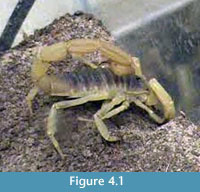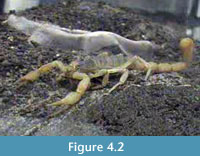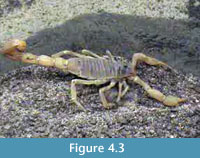FIGURE 1. 1) General scorpion morphology. ct: cephalothorax; ms: mesosoma; mt: metasoma; pd: pedipalp; ch: chelicerae; te: telson; w1-4: walking legs. 2) Specimen of Hadrurus arizonensis used in this study. 3) Known H. arizonensis distribution in the United States.

FIGURE 2. Quantitative burrow description models. 1) Burrows were described by their maximum depth (D), tunnel and shaft width (w), height (h), and circumference (c), total length (L), and branching angle (BA). Burrows were divided into segments (s), surface openings (e), and chambers (h). 2) Complexity is a measure of the number of segments, chambers, and surface openings (e) within a single burrow system. 3) Tortuosity is a measure of the average sinuosity of all of the segments of a burrow system. The tortuosity of a single segment is found by dividing the total length (u) by the straight line distance (v).

FIGURE 3. Burrowing methods used by H. arizonensis. 1) Excavation by kicking sediment behind the body using the first two walking legs. The pedipalps are held up and are not involved in burrowing. 2) Excavation by kicking sediment using the first three walking legs. 3) Excavation by gathering sediment with the first three walking legs and dragging it away from the site of active excavation.

FIGURE 4. Burrowing methods used by H. arizonensis. 1) Excavation by kicking with the first two walking legs, oblique view. 2) Excavation by kicking with the first three walking legs, overhead view. 3) Excavation by dragging with the walking legs, side view.
FIGURE 5. Surface morphology produced by H. arizonensis burrowing. 1) Experimental tank containing 75% sand and 25% clay with a flat, even surface. 2) Experimental tank containing 25% sand and 75% clay with a flat, even surface. 3) Ripples and depressions produced in low density sediment after seven days. 4) Ripples and depressions produced in low density sediment after 14 days; surface relief is approximately 15 cm. 5) Overhead views of a burrow opening beneath a rock (A) and within an excavated pit (B). 6) Oblique view of a burrow opening within an excavated pit.

FIGURE 6. Subvertical ramps. 1) Left oblique view of a typical subvertical ramp (DHS2). 2) Right oblique view of a typical subvertical ramp (DHS17). 3) Overhead view of a subvertical ramp with a sharp curve (DHS10).

FIGURE 7. Subvertical ramps. 1) Left oblique view of an elongate, curved subvertical ramp (DHS17). 2) Side view of a subvertical ramp with a short branch (DHS16). 3) Overhead view of a subvertical ramp with a short branch and a chamber near the burrow entrance (DHS16).

FIGURE 8. U-shaped burrows. 1) Side view of a typical U-shaped burrow (DHS4). 2) Side view of a U-shaped burrow (DHS9) showing the large difference in angles between each shaft (40° and 90°) typical of H. arizonensis burrows of this type.

FIGURE 9. Helical burrow casts. 1) Oblique view of a short, highly tortuous helical burrow (DHS3). The terminal chamber is directly below the burrow opening. 2) Side view of an elongate (76 cm) helical burrow with a low tortuosity (DHS15). 3) Side view of a highly tortuous helical burrow (DHS3). 4) Oblique view of an elongate helical burrow with a low tortuosity (DHS15).

FIGURE 10. Mazeworks. 1) Overhead view of a mazework consisting of a U-shaped burrow and two subvertical ramps (DHS8). 2, 3) Side views of mazework consisting of a U-shaped burrow and two subvertical ramps (DHS8). 4) Underside of a mazework (DHS4); a short tunnel (A) connects a subvertical ramp (B) and a U-shaped burrow (C).

FIGURE 11. Mazeworks. 1) Side view of a mazework consisting of three U-shaped burrows (DHS5). 2) Side view of a mazework consisting of two U-shaped burrows and a subvertical ramp (DHS4).

FIGURE 12. Biogenic cross lamination. 1) Production of laminae (at arrow) by a specimen of H.arizonensis during excavation by the kick method. 2) Ripple forms produced by H. arizonensis (at arrows) with cross lamination visible in cross section. 3) Two stacked cross-laminated ripple forms. 4, 5) Stacked ripples show in (3) after two days; the upper ripple has grown and migrated to the left. 6) Steeply dipping set of biogenic cross laminae.

FIGURE 13. Burrows produce by other arachnids. 1) Oblique view of a large helical burrow produced by Pandinus imperator. 2) Oblique view of a mazework produced by Mastigoproctus giganteus.





